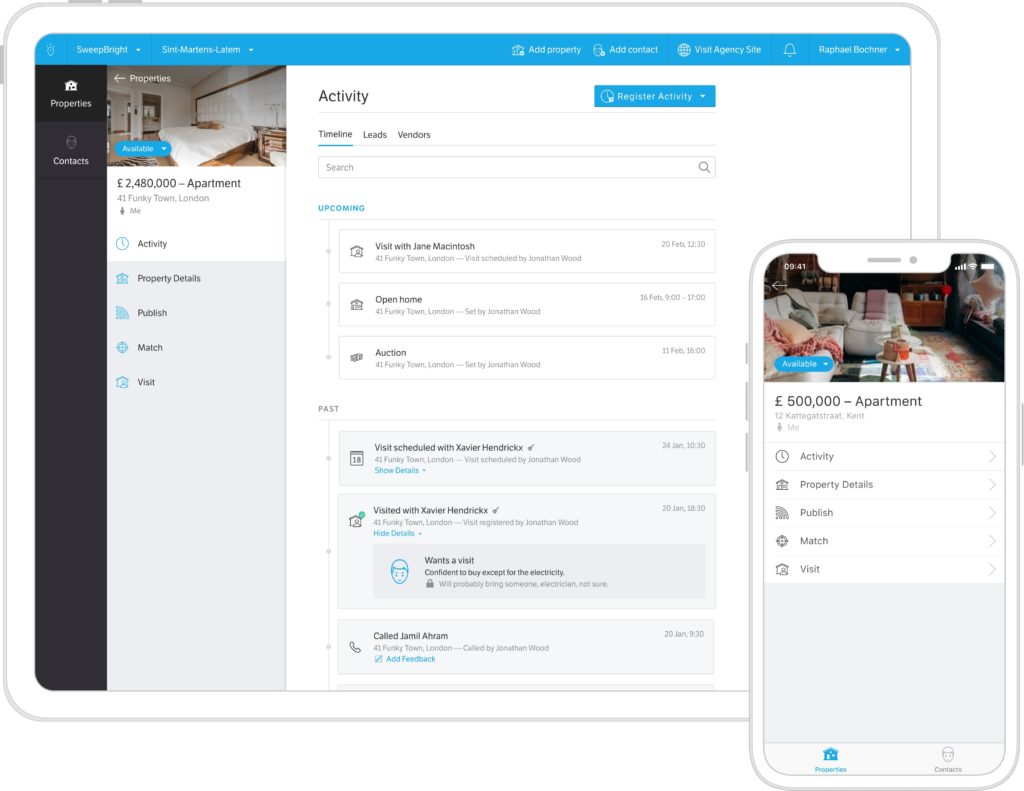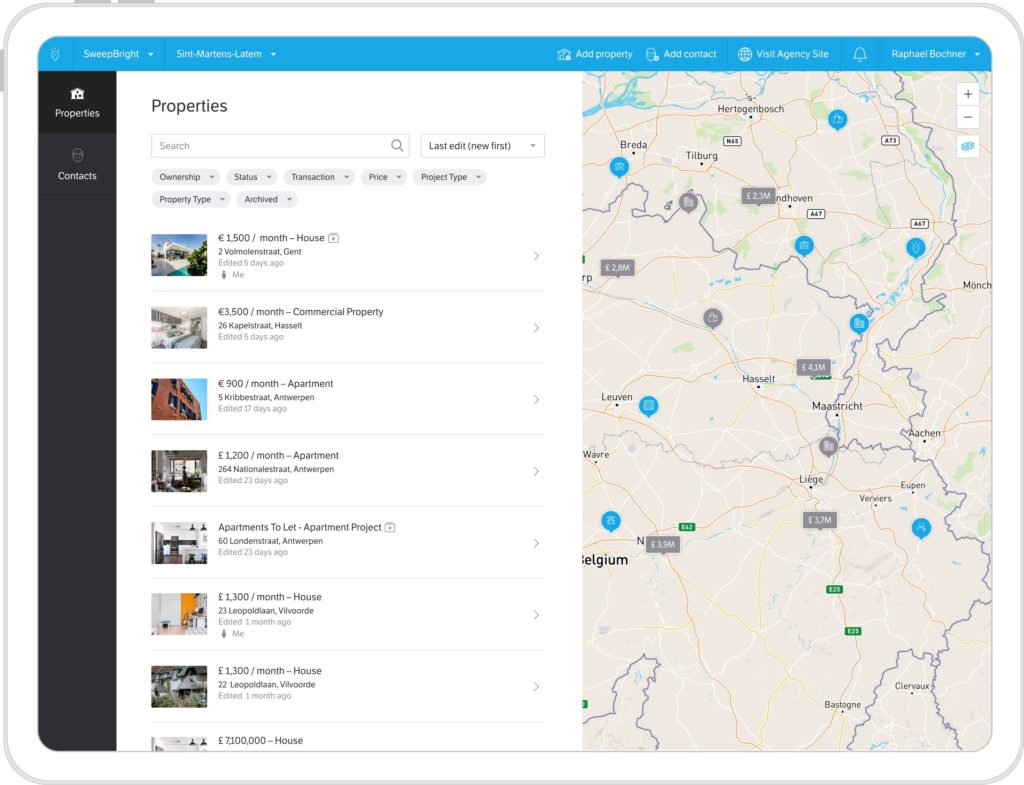Key insights from a product manager
Xavier was interviewed by Userlane on his role as a product manager for SweepBright.
With Mono, we’ve been working on the SweepBright project for quite some time. Our role evolved from doing design only to product management and design.
SweepBright is a SaaS scale-up that transforms the real estate sales flow into a digital journey, empowering real estate agencies to provide an exceptional customer experience.
With Userlane’s permission, we are reposting this content on our blog.
How do you define and create your product roadmap? And what are your thoughts on making your roadmap public?
Xavier: In my current role at SweepBright, the roadmap is volatile. That’s because it’s a startup. It’s all about agility: adapt or die. Laying out a strategic plan for six months makes no sense because you’re looking for product-market fit. We’re working now on things we were going to do in six months and vice versa. You need the flexibility of mind to change priorities regularly. At the same time, you need to create enough peace of mind for the engineers and designers so that they can be awesome at shipping a product they can be proud of.
Time is an extremely limited resource, so my job is to balance rolling out an improved navigation model versus rewriting a core module so it can handle double the load. It takes discussions across the entire organization to understand what the fundamental problems are, how critical they are to the business and how simple the solutions can be. It helps tremendously to have some data points here. Which is why we have recently added a dedicated UX Researcher to the team who helps with setting up measuring tools and gathering and presenting that data. Ultimately, the priority is a decision that I take based on discussions, data, and a little bit of intuition.

Those decisions go into a roadmap document we maintain on Notion (one of my favorite tools in years, really). It’s a board that contains the columns “Planned” for what we think will likely be next, “In Development” for what we’re currently focused on, “Launched” to celebrate what we’ve successfully shipped, and “Ideation” for ideas that still need a clearer problem definition or data.
We don’t publish our roadmap at this point. Up to today, it would have only lead to broken promises towards customers because it’s still so much in flux. A broken promise is much worse than saying, “we don’t know when we’ll ship that feature but you’ll be the first to know when we do!” I can see us publishing a roadmap in the future though, today we’re not entirely at that point where it makes sense yet.
(Update: today, the roadmap is visible to customers.)
What criteria do you usually use for feature prioritization?
Xavier: For the sake of brevity I’ll consider features anything that is not a bug or technical housekeeping.
At SweepBright, we have a small team and very big dreams. Which is why we need focus. All feature suggestions need a clear problem definition and preferably data that back up the problem statement. We’ve had requests from people who were working a lot with one particular customer, they felt we really needed a specific feature. When our UX Researcher came back with data, it was clear that only this customer was having that particular problem. So we deprioritized the feature. We can’t afford to spend time on features that cater to one loud customer only. We need evidence that at least other customers can benefit from that same feature.
If the problem statement and the data are there, we still ask ourselves, “Will it help us sell to the right customers?” Every company goes through different phases, and we are at a phase where finding the right customers is the number one priority. The second one is keeping current customers happy. I believe that if you do it right, there is a big overlap between what helps you sell and what helps you keep the right customers. So far this strategy seems to be working well since we have one of the lowest single digit churn rates I have ever seen at a B2B SaaS company.
Still, you end up with a mountain of work. Then it ultimately comes down to where you want to take the product and whether the features fit in the current vision. I’m a designer, so even if I want to be neutral, the final cut of the product will still be a design-heavy one. For a product like SweepBright, the UX is the crucial competitive advantage that others can ultimately copy, but not innovate around. That is something the CEO understands really well. So we have to keep looking forward and prioritize UX innovation and improvements.

How do you empathize with your users? And how do you interact with them? What do you believe is the best way to interact/ work with them?
Xavier: I’ve been lucky to have been in Product Design and UX Research roles before. I learned that inviting people to your office so you can observe them do a thing in a controlled environment is probably the least effective way to empathize. My favorite method is field research; become your customer’s student and see them for the masters of their craft that they are. I’ve joined realtors while selling, students while attending class, doctors while teaching, translators while writing. There’s tremendous power in just observing and learning something you know nothing about. It’s one of the hardest things for me because people usually look to me for answers. Shutting up and listening doesn’t always come naturally, it’s a skill I’ve had to learn.
Customer Success also plays a huge role here. They are the first line of contact for existing customers and they really feel the pain points of the software first hand. In our case they also regularly invite customers to come and speak about their job to the entire team – and this is crucial. It’s not just the Product people that have to empathize, the entire organization has to do that. This creates a common point of reference for any talks you have with engineers or Sales or leadership later. Even though Customer Success and I have plenty of discussions about priorities, I’m lucky to be working with such smart people.
What are the most exciting tech trends at present? And why?
Xavier: You’ll see buzzwords like AR/VR, blockchain, and Internet of Things, but the most exciting trend for me is the coming of age of machine learning. We’re at a crossroads today where it’s normal for people coming into tech to start playing around with it as if it’s Lego, and it’s super exciting. The hardware is there, the libraries are there, and you only need a basic understanding of computers to start playing around with things like Google AutoML. It’s mind-blowingly powerful when you democratize that.
I’m confident that machine learning is much more than a trend. Trends are ephemeral in nature. However, this is the kind of technology that we will realize in fifteen years has marked the beginning of a new era in tech, much like hypertext did in the nineties: It makes things possible that we cannot quite grasp yet.
If you are interested in the answers from other product managers, you can read the full article at Userlane.
Subscribe to our newsletter
Receive blog highlights and fresh insights into UX/UI and front-end development.
Leave a comment
Your email address will not be published. Required fields are marked *
1 thought on “Key insights from a product manager”
15 Aug 2025 at 09:22